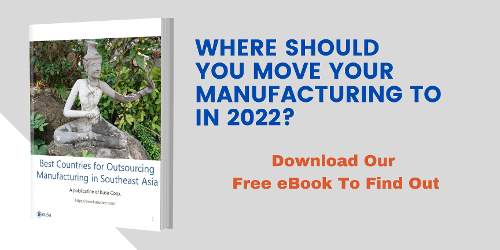The South China Sea disputes have been a source of geopolitical tensions between Southeast Asia and...
The State of the COVID-19 Pandemic In Southeast Asia
As we enter 2022, COVID-19 rages on. The new Omicron variant has cast greater doubt on market forecasts and has caused concerns surrounding the surge of COVID-19 cases and a new wave.
As a result, it is important to continue to monitor the current COVID-19 outlook in our own country and other countries we hope to do business in (e.g., Southeast Asia).
In today’s article, we'll explore the current COVID-19 situations in Singapore, Malaysia, Vietnam, Indonesia, and the Philippines and the impact it has had or may have on their economies.
Singapore
|
Daily Confirmed Cases per Million |
Deaths per Million |
Daily Tests per Thousand |
Daily Population Vaccination Rate |
Population with at Least One Vaccine Dose |
COVID-19 Stringency Index |
|
161.99 (15/01/2022) |
0.16 (15/01/2022) |
3.05 (08/11/2021) |
0.92% (10/01/2022) |
88.4% (10/01/2022) |
44.44 (06/01/2022) |
|
Source: Our World in Data |
|||||
Singapore is arguably among the most successful Southeast Asian countries in terms of managing the COVID-19 pandemic. It has been able to maintain a delicate balance between the number of cases and the number of lockdowns imposed, having on average fewer daily confirmed cases and deaths per million as well as fewer stringent measures in place.
This is perhaps due to its extensive vaccine rollout. In fact, it has the highest percentage of people with at least a single vaccine dose and the second highest daily population vaccination rate. CNBC reports that Singaporeans have taken more precarious measures by mandating booster shots, revoking individuals’ fully vaccinated status after 270 days should they not receive their booster shot.
However, that is not to say that Singapore has been managing the pandemic perfectly. It has had an effect on the economy. Nikkei forecasts GDP growth to slow down from 6.8% in 2021 to 4.3% in 2022 and 3.6% in 2023. Though, Bloomberg continues to be “optimistic about the city-state’s growth prospects as local infections subside.”
Moreover, CNBC reports that the CDC has decided to update Singapore’s COVID-19 status to “unknown” due to old testing info on the “Our World in Data” database. Singapore is in negotiations with the CDC to change this status, arguing that it has the relevant information, writes the SCMP.
Malaysia
|
Daily Confirmed Cases per Million |
Deaths per Million |
Daily Tests per Thousand |
Daily Population Vaccination Rate |
Population with at Least One Vaccine Dose |
COVID-19 Stringency Index |
|
95.92 (15/01/2022) |
0.55 (15/01/2022) |
3.61 (10/01/2022) |
0.66% (15/01/2022) |
79.5% (10/01/2022) |
50.46 (06/01/2022) |
|
Source: Our World in Data |
|||||
Malaysia, on the other hand, has had a more turbulent experience in managing the pandemic. While statistics are more tapered now, it faced a peak of 21,000 daily cases as recently as September, 2021, according to the National News. Cases are seemingly manageable at the moment; though, the Omicron variant is not yet the dominant strain, writes the Straits Times.
While it reopened most businesses and lifted domestic travel restrictions in October, the lockdowns it implemented had disastrous effects on the economy. Former Prime Minister Muhyiddin states, in an interview with National News, the lockdown led to losses of millions of dollars per day. As a result, according to Nikkei, its GDP growth in 2021 was limited to 3.3%.
Though, it is expected to rebound in 2022, with GDP growth of 6%. Admittedly, this forecast does not factor the economic impact from the massive floods engulfing the country; however, it can be assumed that Malaysia’s road ahead should be more stable. After all, it does have the second highest vaccination rate, with 79.5% of the population having received at least one vaccine dose.
Vietnam
|
Daily Confirmed Cases per Million |
Deaths per Million |
Daily Tests per Thousand |
Daily Population Vaccination Rate |
Population with at Least One Vaccine Dose |
COVID-19 Stringency Index |
|
191.31 (15/01/2022) |
1.98 (15/01/2022) |
0.94 (10/01/2022) |
1.17% (14/01/2022) |
80% (14/01/2022) |
68.52 (03/01/2022) |
|
Source: Our World in Data |
|||||
Vietnam has similarly been prioritising its economy, following various stringent measures (it has the second highest COVID-19 Stringency Index valuation). Last week, the Vietnamese Parliament approved a USD 15.3 billion stimulus package aimed at aiding businesses, aiding workers, and promoting infrastructure development, writes Al-Jazeera.
Parliament also approved a 2022-2023 budget deficit increase valued at approximately USD 10 million. Again, it is clear that the Vietnamese government will continue to prioritise economic recovery as opposed to its historical Zero COVID-19 policies.
However, these efforts have been hindered by the recent border closures by China. According to the SCMP, a local surge in COVID-19 cases in regions bordering the Vietnamese border saw borders close, in accordance with China’s Zero COVID-19 policies, and thousands of Vietnamese trucks halted and the price of Vietnamese fruits plummeted.
In order to combat the projected uptick in COVID-19 cases (evidenced by its daily confirmed cases per million statistics), the Vietnamese government has begun considering vaccinations for children as young as 5-11 years old, states the Star. However, Vietnam already has a sizeable percentage of the population vaccinated. While Our World in Data states 80% of the population has had at least one dose, Xinhua reports the entire adult population has received at least one dose.
Indonesia
|
Daily Confirmed Cases per Million |
Deaths per Million |
Daily Tests per Thousand |
Daily Population Vaccination Rate |
Population with at Least One Vaccine Dose |
COVID-19 Stringency Index |
|
2.65 (15/01/2022) |
0.02 (15/01/2022) |
0.69 (13/01/2022) |
0.46% (15/01/2022) |
63.6% (15/01/2022) |
66.20 (09/01/2022) |
|
Source: Our World in Data |
|||||
Indonesia, on the other hand, is looking to revamp its economic recovery plan. Nikkei reports “Indonesia's economic engine will shift from external trade to domestic demand starting in 2022 onward, providing a healthy environment and stable politics." Consequently, the government has passed a fiscal stimulus package of USD 51.7 billion.
However, domestic household consumption growth remains limited owing to slow stimulus liquidation, states the East Asia Forum. Only 68.6% of the package had been liquidated in December, 2021. Moreover, only 35% of the total budget allocated to the local government remains unspent in November 2021, equivalent to USD 44.58 billion.
Moreover, Indonesia’s tourism industry was hit hard by COVID-19 restrictions, reports Al-Jazeera. Indonesia’s mandatory hotel quarantine for all travellers who enter its borders, regardless of vaccination status, is arguably the single largest factor. Indonesia’s highest daily increase in cases in three months, according to the Guardian, could also be a factor.
The slowest daily vaccination rate (0.46%), caused by geographic and logistical limitations, could be another factor. Nonetheless, “Indonesia's GDP growth estimate remained unchanged at 5.0% in 2022, up from a projected 3.5% this year,” writes Nikkei. An increase in FDI may also be facilitated by the new Omnibus Law passed by parliament in 2021.
Philippines
|
Daily Confirmed Cases per Million |
Deaths per Million |
Daily Tests per Thousand |
Daily Population Vaccination Rate |
Population with at Least One Vaccine Dose |
COVID-19 Stringency Index |
|
297.82 (15/01/2022) |
0.93 (15/01/2022) |
0.61 (09/01/2022) |
0.70% (13/01/2022) |
50.50% (02/12/2021) |
74.54 (27/12/2021) |
|
Source: Our World in Data |
|||||
The Philippines has ramped out vaccine rollouts and vaccine mandates. According to the Guardian, it has imposed a controversial ban that barrs unvaccinated people from public transport and new rules that prevent unvaccinated people from leaving their homes unless it is for going to work, to buy groceries, or to access medical services. Children under 18 are similarly barred.
The Philippines government has also begun imposing tighter COVID-19 restrictions. Schools south of the capital are to be closed until the end of the month, states the New York Times. Capacity limits for restaurants, malls, parks, sports venues, fitness studios, cinemas, exhibitions, and social events have also been reintroduced.
According to Inquirer, “[The Philippines] remained as the most vulnerable country to COVID-19 in the latest scorecard of UK-based think tank Oxford Economics.” It was arguably the Southeast Asian economy hardest hit by the pandemic.
This is especially considering the Philippine economy relies heavily on the travel, tourism, and hospitality sectors (these sectors account for 25% of the GDP). The weekly USD 58 million losses resulting from stringent lockdowns that were only recently lifted did not help either. Consequently, doubts have been cast over Nikkei’s growth forecast of 7.1% in 2022 and 5.9% in 2023.
So what does it all mean for you?
For now, it remains unclear as to how the COVID-19 pandemic as a whole, in addition to the new Omicron variant, may affect various Southeast Asian countries, their people, and their economies. All we have are forecasts and estimates.
Therefore, it is imperative we continue to monitor and to pay attention to any and all developments that emerge from Southeast Asia. Southeast Asia is, after all, a key global economic hub. We at Kusu constantly strive to offer you and your company a greater understanding of the Southeast Asian Market.
If you and your company are interested in gaining a better understanding of Southeast Asia, and especially the Southeast Asian manufacturing sector, be sure to follow Kusu’s newsletter and blogs. We are here to aid you in any way we can.
-1.jpg?width=146&height=50&name=Kusu%20(1)-1.jpg)



